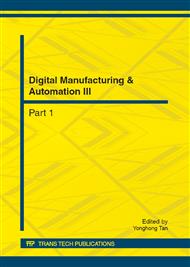[1]
SANGJOOK, WANKC,YOUNGILY. On the coarse/fine dual-stage manipulators with perturbation compensator [C].Proceedingsofthe2001IEEE International Conference on Robotic and Automation .Seoul, Korea May, 2001, pp.121-126.
Google Scholar
[2]
H. T. Banks and R. C. Smith, Hysteresis Modeling in Smart MaterialSystems, J. Appl. Mech. Eng, vol. 5, pp.31-45, 2000.
Google Scholar
[3]
Ying Feng, Camille Alain Rabbath, Tianyou Chai, Chun-Yi Su ,Robust Adaptive Control of Systems with Hysteretic nonlinearities:A Duhem Hysteresis Modelling Approach, IEEE AFRICOM 2009 pp.1-6.
DOI: 10.1109/afrcon.2009.5308329
Google Scholar
[4]
L. Xu and B. Yao, "Output feedback adaptive robust precision motion control of linear motors," Automatica, vol. 37, no. 7, pp.1029-039, 2001.
DOI: 10.1016/s0005-1098(01)00052-8
Google Scholar
[5]
K. K. Tan, T. H. Lee, and H. X. Zhou, "Micro-position of linear-piezoelectric motors based on a learning nonlinear PID controller," IEEE/ASME Trans. Mechatron., vol. 6, no. 4, pp.428-36, Dec. 2001.
DOI: 10.1109/3516.974856
Google Scholar
[6]
F. Janabi-Sharifi, V. Hayward, and C.-S. J. Chen, "Discrete-time adaptive windowing for velocity estimation," IEEE Trans. Contr. Syst. Technol., vol. 8, no. 6, pp.1003-1009, Nov. 2000.
DOI: 10.1109/87.880606
Google Scholar
[7]
J. Q. Han, W. Wang, "Nonlinear tracking differentiator," J. Sys. Sci & Math. Sci. vol.14, no.1, pp.177-183, 1994. (In Chinese).
Google Scholar
[8]
JinHyoung Oh and Dennis S. Bemstein Identification of Rate-Dependent Hysteresis Using the Semilinear Duhem Model, Proceeding of the 2004 American Control Conference,4776-4781[11] H. T. banks and R. C. Smith, "Hysteresis Modeling in Smart MaterialSystems," J. Appl. Mech. Eng, vol. 5, pp.31-45, 2000.
DOI: 10.23919/acc.2004.1384068
Google Scholar
[9]
J. Oh and D. S. Bernstein, Semilinear Duhem model for rate-independent and rate-dependent hysteresis, IEEE Trans. Autom. Control, vol.50, no. 5, p.631–645, May 2005.
DOI: 10.1109/tac.2005.847035
Google Scholar
[10]
Chen hui TanYong-hong, Zhou Xingpeng Identification and control of dynamic modeling for piezoceramic actuatorGuangxue Jingmi Gongcheng/Optics and Precision Engineering, v 20, n 1, pp.88-95, January 2012 (In Chinese).
Google Scholar
[11]
J. Q. Han, W. Wang, Nonlinear tracking differentiator, J. Sys. Sci & Math. Sci. vol.14, no.1, pp.177-183, 1994. (In Chinese).
Google Scholar
[12]
Songsheng, Approximation of Functions [M]. Publishing House of Beijing Normal University, Beijing. 1989.3
Google Scholar


